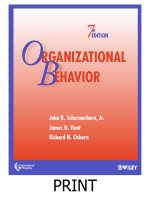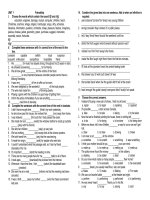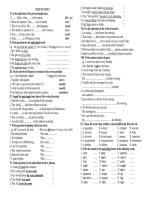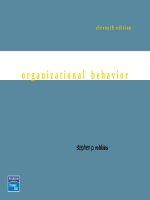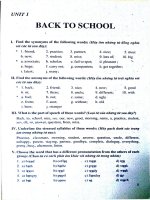Organizational behavior lecture notes unit 1 OB
Bạn đang xem bản rút gọn của tài liệu. Xem và tải ngay bản đầy đủ của tài liệu tại đây (3.04 MB, 13 trang )
Unit 1 slide text
Slide 1
Explain
Explain
The following management functions can be used to classify the manager’s job.
1
Planning means defining an organization’s goals, establishing an overall strategy for
achieving these goals, and developing comprehensive plans to integrate and coordinate
activities.
Organizing includes determining what tasks must be done, who will do them, how the
tasks will be grouped, who will report to whom, and where decisions will be made.
Leading includes motivating and directing employees, and communicating and resolving
conflicts.
Controlling means monitoring performance, comparing results and goals, and making
corrections.
In the 1960s, Henry Mintzberg concluded that managers perform ten roles that can be
grouped around three themes: interpersonal relationships, information transfer, and
decision making.
Managers perform three types of interpersonal roles:
•
Figureheads perform ceremonial or symbolic roles.
•
Leaders train, motivate, and discipline employees.
•
Liaisons contact external information sources.
Managers perform three types of informational roles:
•
Monitors collect marketplace information from outside sources.
•
Disseminators transmit information to organizational members.
•
Spokespersons represent their organizations to outsiders.
Managers perform four types of decisional roles:
•
Entrepreneurs initiate and oversee new projects to improve organizational
performance.
•
Disturbance handlers take action to respond to unforeseen problems.
•
Resource allocators control human, mechanical, and monetary resources.
•
Negotiators bargain with others to gain advantage for their own units.
2
Effective managers must exercise the following three essential skills:
•
•
•
Technical skills refer to specialized knowledge or expertise.
Conceptual skills refer to the mental ability to analyze and diagnose
complex situations.
Human skills encompass the ability to work with, understand, and
motivate people, both individually and in groups.
Fred Luthens and his associates studied over 450 managers and found that they all
engaged in four managerial activities:
1.
2.
3.
4.
Traditional management. Decision making, planning, and controlling.
Communication. Exchanging routine information and processing
paperwork.
Human resource management. Motivating, disciplining, managing conflict,
staffing, and training.
Networking. Socializing, politicking, and interacting with outsiders.
3
Organizational behavior (OB) is a field of study that investigates the impact that
individuals, groups, and structure have on behavior within organizations. The purpose of
investigating these elements is to apply such knowledge toward improving the
effectiveness of an organization. OB includes the core topics of motivation, leader
behavior and power, interpersonal communication, group structure and processes,
learning, attitude development and perception, change processes, conflict, work design,
and work stress.
These need to balance
4
Organizational behavior is an applied behavioral science that is built upon contributions
from a number of behavioral disciplines.
Psychology is the science that seeks to measure, explain, and sometimes change the
behavior of individuals. The following areas of psychology have contributed to the
knowledge base of OB: learning and personality theorists, counseling psychologists, and
industrial and organizational psychologists.
Sociology, the study of people in relation to their fellow human beings, has contributed to
OB in the following areas: group dynamics; design of work teams; organizational culture,
theory, structure, and technology; and power, communications, and conflict.
Social psychology blends concepts from psychology and sociology to focus on how
people influence one another. Social psychologists have made significant contributions in
the areas of measuring, understanding, and changing attitudes; communication patterns;
the ways in which group activities can satisfy individual needs; and group decisionmaking processes.
Anthropology is the study of societies to learn more about human beings and their
activities. Much of our current understanding of organizational cultures and
environments, and the differences among national cultures is the result of the work of
anthropologists.
Political science is the study of the behavior of individuals and groups within a political
environment. Specific topics of concern include structuring of conflict, allocation of
power, and how people manipulate power for individual self-interest.
The global world!
5
The Big D
The packages
Not necessary
6
Discuss by region
Discuss motivation controversy
Not necessary
7
Explain
In a workplace characterized by cutbacks, intense global competition, and expectations of
higher worker productivity, it is not surprising that many employees feel pressured to cut
corners, break rules, and engage in other questionable activities. So members of
organizations are often faced with ethical dilemmas, in which they must define right and
wrong conduct. But ethical behavior is tough to define, especially when employees can
find evidence of unethical behavior at all social and organizational levels.
Organizations are responding to this problem in a number of ways.
1.
2.
3.
4.
Writing and distributing codes of ethics to guide employees through ethical
dilemmas.
Offering seminars, workshops, and training to improve ethical behaviors.
Providing in-house advisers who can assist with ethical issues.
Creating protection mechanisms for employees who reveal internal
practices that are unethical.
8
Ask question What is dependant variable
Ask question What is independent variable
Unit 2
9
In classical conditioning, an individual responds to some stimulus that would not
ordinarily produce such a response. This theory grew out of Pavlov’s experiments to
teach dogs to salivate in response to the ringing of a bell. When Pavlov gave a dog a
piece of meat, the dog would salivate. The meat was an unconditioned stimulus; the
salivation of the dog was the unconditioned response. The bell, on the other hand, was a
conditioned stimulus that was originally neutral. Pavlov paired the bell with the meat,
which caused the dog to associate the sound of the bell with being fed. Over time, the
sound of the bell alone produced a conditioned response by making the dog salivate.
Classical conditioning is passive. Something happens, and we react in a specific way. As
such, it can explain simple, reflexive behaviors.
In operant conditioning, desired voluntary behavior leads to a reward or stops a
punishment. This theory argues that behavior is a function of consequences. Operant
behavior is learned or voluntary, not reflexive or unlearned. B. F. Skinner argued that
creating pleasing consequences to follow specific forms of behavior would increase the
frequency of that behavior. He said that rewards are most effective if they immediately
follow the desired response and that behavior that is not rewarded, or is punished, is less
likely to be repeated.
Social-learning theory proposes that we can learn through observation and direct
experience. This theory is an extension of operant conditioning and assumes that behavior
is a function of its consequences. It also acknowledges the role of perception in learning.
The use of models is central to the social-learning theory, and the following four
processes determine how a model will influence an individual: retention, attention, motor
reproduction, and reinforcement.
Shaping behavior involves systematically reinforcing each successive step that moves an
individual closer to the desired response. There are four ways in which to shape behavior.
1.
Positive reinforcement is following a response with something pleasant.
2.
Negative reinforcement is following a response with the termination or
withdrawal of something that is unpleasant.
3.
Punishment is causing an unpleasant condition in an attempt to eliminate an
undesirable behavior.
4.
Extinction is the elimination of any reinforcement that is maintaining
behavior.
A continuous reinforcement schedule reinforces the desired behavior every time it is
demonstrated. While not every incident of the desired behavior is reinforced in an
intermittent schedule, reinforcement is given often enough to reinforce the behavior. An
intermittent reinforcement can be of a ratio or interval type. In ratio schedules, the
individual is reinforced after giving a certain number of specific types of behavior.
Interval schedules depend upon how much time has passed since the last reinforcement.
In fixed-interval types, rewards are spaced at uniform time intervals. In variable-interval
types, reinforcements are unpredictable. In a fixed-ratio schedule, after a fixed number of
10
responses are given, a reward is initiated. When the reward varies relative to the behavior
of the individual, he or she is on a variable-ratio schedule.
Because continuous reinforcement can lead to early satiation, behavior weakens rapidly
when reinforcers are withheld. Continuous reinforcers are appropriate for newly emitted,
unusual, or low-frequency responses. Since intermittent reinforcers preclude early
satiation, they are appropriate for stable or high-frequency responses. In general, variable
schedules lead to higher performance than fixed schedules.
Unit 3
Values represent basic convictions that a “specific mode of conduct or end-state of
existence is personally or socially preferable to an opposite or converse mode of conduct
or end-state of existence.”
Milton Rokeach created the Rokeach Value Survey (RVS) which consists of two sets of
values: terminal values or desirable end-states of existence and instrumental values,
preferable modes of behavior or means of achieving the terminal values.
The following are some examples of terminal values: a world of peace, a sense of
accomplishment, a world of beauty, equality, freedom, and salvation.
The following are some examples of instrumental values: capable, cheerful, courageous,
imaginative, logical, loving, and responsible.
Several studies confirm that RVS values vary among groups. People in the same
occupations or categories, such as corporate executives, union members, or community
activists, tend to hold similar values. The variance in RVS values among such groups is
significant because they all have a vested interest in what corporations do.
Workers who grew up influenced by the Great Depression, World War II, U.S. leadership
in world manufacturing, the Andrews sisters, and the Berlin blockade entered the
workforce from the mid-1940s to the late 1950s. They believe in the Protestant work
ethic. Once hired, they tend to be loyal to an employer. They are likely to value family
security and a comfortable life.
Employees who entered the workforce from the 1960s to the mid-1970s were influenced
by John F. Kennedy, the civil rights movement, the Beatles, and the war in Vietnam. They
brought with them a large measure of the “hippie ethic” and existential philosophy.
Quality of life is more important to them than money and possessions. They value
autonomy, freedom, and equality.
Those who entered the workforce from the mid-1970s through the mid-1980s reflect
society’s return to more traditional values but with a greater emphasis on achievement
and material success. They were influenced by Ronald Reagan conservatism, the defense
build-up, dual-career households, and $150,000 starter homes. As pragmatists, they
believe that the ends can justify the means. A sense of accomplishment and social
recognition rank high for them.
The lives of the members of Generation X have been shaped by globalization, the fall of
Communism, MTV, AIDS, and computers. They value flexibility, life options, job
11
satisfaction, family, and relationships. Money is important as an indicator of career
performance, but they are less willing to trade off leisure time for increases in salary,
titles, security, and promotions.
One of the most widely referenced approaches for analyzing variations across cultures
was done by Geert Hofstede. After surveying 116,000 IBM workers in 40 countries, he
found that managers and employees differ on the following five value dimensions of
national culture:
Power distance. This is the degree to which people accept that power in institutions and
organizations is distributed unequally. The range is from relatively equal (low power
distance) to very unequal (high power distance).
Individualism is the degree to which people in a country prefer to act alone rather than as
members of groups. Collectivism is the equivalent of low individualism.
Quantity of life is the degree to which people value assertiveness, competition, and the
acquisition of money and possessions. Quality of life is the degree to which people value
relationships and show sensitivity and concern for others.
Uncertainty avoidance is the degree to which people prefer structured over unstructured
situations. People who score high on uncertainty avoidance have an increased level of
anxiety.
People in long-term orientation countries look to the future and value thrift and
persistence. A short-term orientation values the past and present and emphasizes respect
for tradition and social obligations.
Most of the concepts that make up the body of knowledge called organizational behavior
have been developed by Americans using subjects within domestic contexts. Therefore,
not all OB concepts and theories are universally applicable to managing in a global
context, especially in countries where work values are considerably different from those
in the United States. So cultural values should be considered when trying to understand
behavior.
Individuals seek consistency. Cognitive dissonance occurs when there are inconsistencies
between two or more of a person’s attitudes or between a person’s attitudes and
behaviors. The theory of cognitive dissonance suggests that people try to minimize
dissonance and the discomfort it causes.
Several moderating factors suggest that individuals who are experiencing dissonance will
not necessarily move directly toward a reduction of the dissonance (consistency). If the
elements creating the dissonance are relatively unimportant, the pressure to correct the
imbalance will be low. Also, the degree of influence that one has over the elements
involved will affect how he or she reacts to dissonance. Rewards also influence the
degree to which individuals are motivated to reduce dissonance.
12
Recent research has demonstrated that attitudes significantly predict future behavior and
that the attitude-behavior relationship can be enhanced by taking moderating variables
into account.
Three powerful moderators are the importance, specificity, and accessibility of the
attitude. In addition, the existence of social pressures and whether a person has direct
experience with the attitude are also strong moderators.
Employee dissatisfaction can be expressed in four types of responses which differ from
one another along two dimensions: constructive/destructive and active/passive.
1.
Exit. Behavior directed toward leaving the organization, such as looking for a
new position or resigning.
2.
Voice. Actively and constructively attempting to improve conditions, such as
suggesting improvements, discussing problems with superiors, and some forms of union
activity.
3.
Loyalty. Passively but optimistically waiting for conditions to improve, such as
speaking up for the organization in the face of external criticism and trusting the
organization and its management to “do the right thing.”
4.
Neglect. Passively allowing conditions to worsen, such as chronic lateness
or absenteeism, reduced effort, and increased error rate.
13
